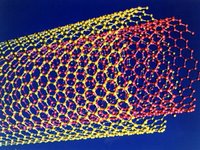Nanotechnology - Say 'Hello' to My Little Friend
I couldn’t resist quoting that line from “Scarface”. On with the show…
In the field of Nanotechnology, smaller is better. Nanotechnology is the science of building small machines – really small machines on the molecular level that will ideally be able to build macro-scale products (regular-sized stuff) from individual molecules. Although the term “Nanotechnology”, may be seem to be the new buzz word in the scientific community, the idea was first introduced in 1959. Yes, the idea of tiny nano-machines was first introduced in a talk by the Nobel Prize-winning physicist Richard Feynman, entitled "There's Plenty of Room at the Bottom". Feynman proposed using a set of conventional-sized robot arms to construct a replica of themselves, but one-tenth the original size, then using that new set of arms to manufacture an even smaller set, and so on, until the molecular scale is reached. Then by controlling millions of these tiny machines via computer, we could program them to work together to create macro-scale products built from individual molecules – a “bottom-up manufacturing” process, instead of cutting away at material until you have the final component or product – “top-down manufacturing.” The advent of nano-scale machines has produced a variety of interesting nanotech pieces parts, such as the nanotube and the bucky ball.
"Conceptually, single-wall carbon nanotubes (SWCNTs) can be considered to be formed by the rolling of a single layer of graphite (called a graphene layer) into a seamless cylinder. A multiwall carbon nanotube (MWCNT) can similarly be considered to be a coaxial assembly of cylinders of SWCNTs, like a Russian doll, one within another; the separation between tubes is about equal to that between the layers in natural graphite. Hence, nanotubes are one-dimensional objects with a well-defined direction along the nanotube axis that is analogous to the in-plane directions of graphite."(1)
"It is the roundest and most symmetrical large molecule known to man. Buckministerfullerine continues to astonish with one amazing property after another. Named after American architect R. Buckminister Fuller who designed a geodesic dome with the same fundamental symmetry, C60 is the third major form of pure carbon; graphite and diamond are the other two."(2)
Buckyballs, being the roundest of round molecules, are very resistant to high speed collisions. It has been found that the buckyball can withstand a crash into a stainless steel plate at 15,000 mph, a bounce back, unharmed. Another interesting property of the buckyball is that when is compressed to 70 percent of its original size, it becomes twice as hard as a diamond.
These tiny structures will have a multitude of applications in medicine, manufacturing, geology, environmental sciences, physics, etc.
For every awesomely potentially good thing there is a dark side. A potentially bleak nanotechnology scenario is explored in the 2002 fiction thriller Prey by Michael Crichton. The story goes something like:
1. Scientists work for a military contractor (Xymos Technology)
2. They develop a shitload of nanomachines for a military surveillance project
3. They implement computer modeled swarm behavior (only a genius would do this..right?)
4. The billions of swarming nanomachines escape from the confines of the lab (we all saw this coming)
5. They become a malevolent swarm of tiny micro monsters after breaking away from the commands of the computer model, killing everything in their path.
There are real dangers of nanotechnology aside from the works of fiction. For example, nanoparticles are made from known elements, such as graphite. The behavior of graphite in our bodies and ecosystem is pretty well known. On the other hand, the nanoparticle version of known elements exhibit undocumented and different behavior than their regular-sized counterparts. While the body has built-in defenses for natural particles it encounters, the danger of nanotechnology is that it is introducing entirely new type of particles. Particles some experts say the body is likely to find toxic.
“Complicating the dangers of nanotechnology, size and shape of nanoparticles affect the level of toxicity, preempting the ease of uniform categories even when considering a single element. In general, experts report smaller particles are more bioactive and toxic. Their ability to interact with other living systems increases because they can easily cross the skin, lung, and in some cases the blood/brain barriers. Once inside the body, there may be further biochemical reactions like the creation of free radicals that damage cells.”(3)
Does the potential good from Nanotechnology outweigh the potential evil? Only time will tell.













0 Comments:
Post a Comment
<< Home